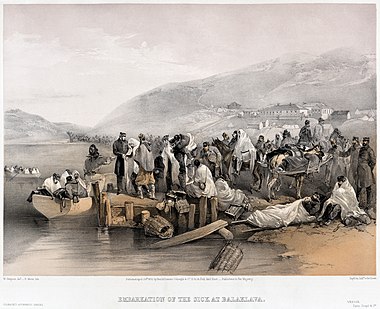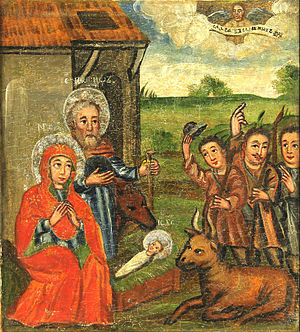Portal:Ukraine/Featured picture
The Selected picture box on the portal chooses one of the following at random when displaying the page. Follow the instructions below for adding or nominating a new picture to the list.
Picture candidates[edit]
Feel free to add related featured pictures to the list. Nominate other pictures on the portal talk page.
- Pictures must be
- Free to use and hosted on Commons
- Of good quality (not blurred, grainy or discoloured)
- Interesting
- Relevant to an article or topic
To find appropriate pictures, use search box below:
Instructions[edit]
- For pictures, which appeared as picture of the day on the Main Page, just add the date in
YYYY-MM-DDformat to the list (please keep the list sorted). - For other pictures, use following parameters:
|iN= |titleN= |creditN= |captionN=
where N is the next unused number.
Selected pictures list[edit]
Map credit: Nicolas de Fer
A 1691 French map of Kamianets-Podilskyi, Ukraine, depicting the city's old town neighborhood and castle, surrounded by the winding Smotrych River. It was originally part of Kievan Rus' and annexed into the First Polish Republic, but at the time of the map's creation, the city was part of the Ottoman Empire. It shortly returned to Poland and later became part of the Russian Empire with the Second Partition of Poland in 1793.
Photo credit: Peter Duhon
Ukrainian fashion model Nataliya Gotsiy modeling for Cynthia Rowley, Spring 2007 New York Fashion Week. She was the winner of the Ford Supermodel of the World 2004 search. She has appeared on the cover of French Elle and Italian Marie Claire and modeled for Behnaz Sarafpour, Christian Lacroix, Diane von Furstenberg, Dior, Dolce & Gabbana, Dries van Noten, Gucci, Oscar de la Renta, Valentino, and Vivienne Westwood, among others.
Winston Churchill, Franklin D. Roosevelt, and Joseph Stalin sitting together at the Yalta Conference, which took place February 4–11, 1945. The so-called "Big Three" met to discuss the re-establishment of the nations of Europe following World War II. Although a number of agreements were reached, Stalin broke his promises regarding Poland, and the Soviet Union annexed the regions of Eastern Europe it controlled, or converted them to satellite states.
Photo: Noodle snacks
Mushrooms of Armillaria hinnulea, a species of honey fungus (or "pidpenky", from Ukrainian). Honey fungi are parasitic fungi that live on trees and woody shrubs. As a forest pathogen, it can be very destructive because unlike most parasites, it does not need to moderate its growth in order to avoid killing its host, since it will continue to thrive on the dead material. Honey fungi are long lived and form some of the largest living organisms in the world, including one that covers more than 3.4 sq mi (8.8 km2) and is thousands of years old. The mushrooms are edible, but can be easily confused with poisonous Galerina species, which can grow side-by-side with Armillaria.
Artist: William Simpson; Lithographer: Edmond Morin; Restoration: NativeForeigner
A tinted lithograph, titled "Embarkation of the sick at Balaklava", shows injured and ill soldiers in the Crimean War boarding boats to take them to hospital facilities. Modern nursing had its roots in the war, as war correspondents for newspapers reported the scandalous treatment of wounded soldiers in the first desperate winter, prompting the pioneering work of women such as Florence Nightingale, Mary Seacole, Frances Margaret Taylor and others.
Artist: William Simpson; Restoration: NativeForeigner
The 6th (Inniskilling) Dragoons and 5th Dragoon Guards engage the Russians in this lithograph of the "Charge of the Heavy Brigade", a short engagement during the Battle of Balaclava during the Crimean War. Russian cavalry had attacked the British camp, but in roughly ten minutes of fighting, they suffered 40 to 50 killed and more than 200 wounded and were forced to retreat.
A map showing caesium-137 contamination in Belarus, Russia, and Ukraine (in curies per square kilometer) in 1996, ten years after the Chernobyl disaster struck the Chernobyl Nuclear Power Plant. The disaster contaminated 162,160 square kilometres (62,610 sq mi) of land and is widely considered the worst nuclear power plant accident in history.
Photograph credit: Max Alpert
Kombat (Russian for 'battalion commander') is a black-and-white photograph by Soviet photographer Max Alpert. It depicts a Soviet military officer, armed with a TT pistol, raising his unit for an attack during World War II. This work is regarded as one of the most iconic Soviet World War II photographs, yet neither the date nor the subject is known with certainty. According to the most widely accepted version, it depicts junior politruk Aleksei Gordeyevich Yeryomenko, minutes before his death on 12 July 1942, in Voroshilovgrad Oblast, now part of Ukraine. The photograph is in the archives of RIA Novosti, a Russian state-owned news agency.
Photograph: George Chernilevsky
The ChS8 is an electric mainline passenger locomotive used in Russia and Ukraine. Built between 1983 and 1989, it was developed for pulling long passenger trains (28–32 carriages) at speeds of 100 kilometres per hour (60 mph) or faster. Since 2010 Russia has switched to more energy-efficient designs, such as the EP10 and EP20.
Photograph: Amakuha
The burning of the Trade Unions Building—used as the headquarters of the Euromaidan movement—during the 2014 Ukrainian revolution, following a failed attempt by the Ukrainian police to capture the building. After the fire, the damaged building was covered with large canvas screens on two sides with the words "Glory to Ukraine" printed on them in large letters.
Painting: Unknown
The Adoration of the Shepherds is a common subject in the Nativity of Jesus in art. The scene, based on the Biblical account in Luke 2, depicts shepherds as near witnesses to the birth of Jesus in Bethlehem, arriving soon after the actual birth. It is often combined in art with the Adoration of the Magi, in which case it is typically just referred to by the latter title. The example here comes from 17th-century Ukraine and is currently held at the Ivan Honchar Museum.
Photograph: Anatoly Shcherbak
The Royal Kurgan is a 4th century BC kurgan (burial barrow) located near present-day Kerch, Crimea. The mound is almost 20 metres high and its base perimeter is about 250 metres. It holds a burial chamber with a square floor plan which gradually merges into the circular shape of a corbelled dome ("false vault"). It is assumed that the Royal Kurgan was the final resting place of a ruler of the Bosporan Kingdom.












